Complete Solutions to Examples of chapter REFRACTION OF LIGHT BY PLANE SURFACES of Class 12 book with complete answers and questions
| Class 12 | PHYSICS |
| Chapter | REFRACTION OF LIGHT BY PLANE SURFACES |
| CP SINGH | Examples |
| Number Of Questions | 50 |
| Academic Year | 2023-24 |
The refractive index of glass with respect to water is `(9//8)`. Refractive index of water with respect to air is `(4//3)`. Find refractive index of glass with air.
01:50View SolutionIf speed of light in a medium is `2xx10^8m//sec`. Find refractive index of medium.
00:52View SolutionFind the speed of light of wavelength `lambda=600nm` (in air) in a medium of refractive index `5//3` and also wavelength of this light in medium.
03:18View SolutionLight of wavelength `500nm` in medium A enters into medium B through a plane surface. If frequency of light is `4xx10^(14)Hz` and `v_A//v_B=4//5`, find absolute refractive indices of media A and B.
03:17View SolutionWhen a light enters from medium 1 to 2, its speed increases by `20%` and when medium 1 to medium 3, its speed decreases by `20%`. Consider the situation in the following figure. Find r.
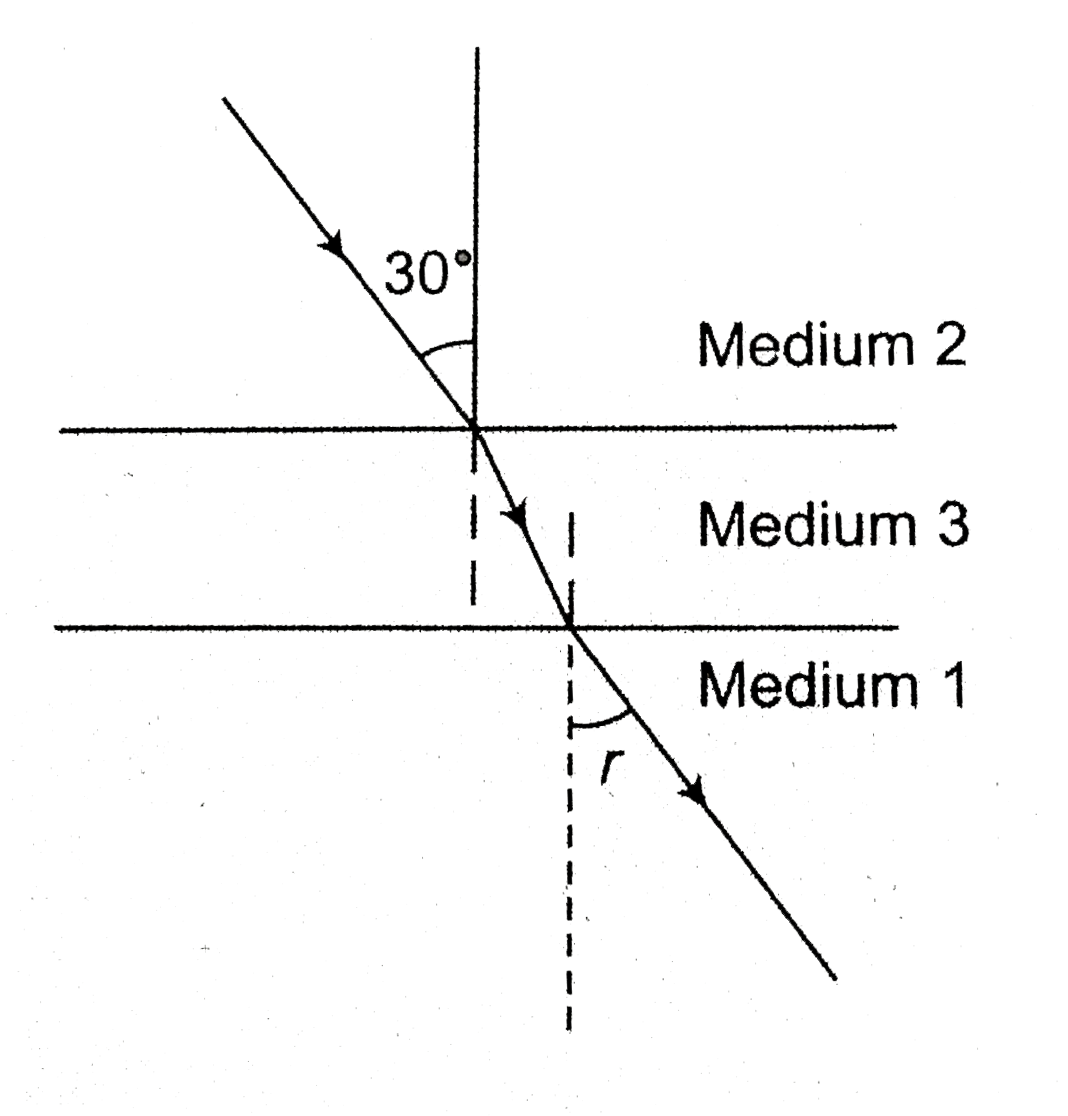 04:17View Solution
04:17View SolutionLight enters from vacuum to a medium of refractive index `mu`. If angle of incidence is double of angle of refraction, find angle of refraction.
02:22View SolutionMonochromatic light falls at an angle of incidence i on a slab of a transparent material (refractive index `mu`). If reflected and refracted rays are mutually perpendicular, find the relation between `mu` and `i`.
02:33View SolutionA light ray falling at an angle of `53^@` with the surface of a clean slab of ice of thickness `1.00m` is refracted into it at an angle of `37^@`. Calculate the time taken by the light rays to cross the slab. Speed of light in vaccum `=3xx10^8m//sec`.
03:36View SolutionA pole standing in a clear water pond stands `1m` above the water surface, the pond is `2m` deep. What are the lengths of the shadows thrown by the pole on the surface and bottom of the pond if the sun is `30^@` over the horizon? `(mu_(water)=4//3)`
10:19View SolutionConsider the situation as shown in the diagram.
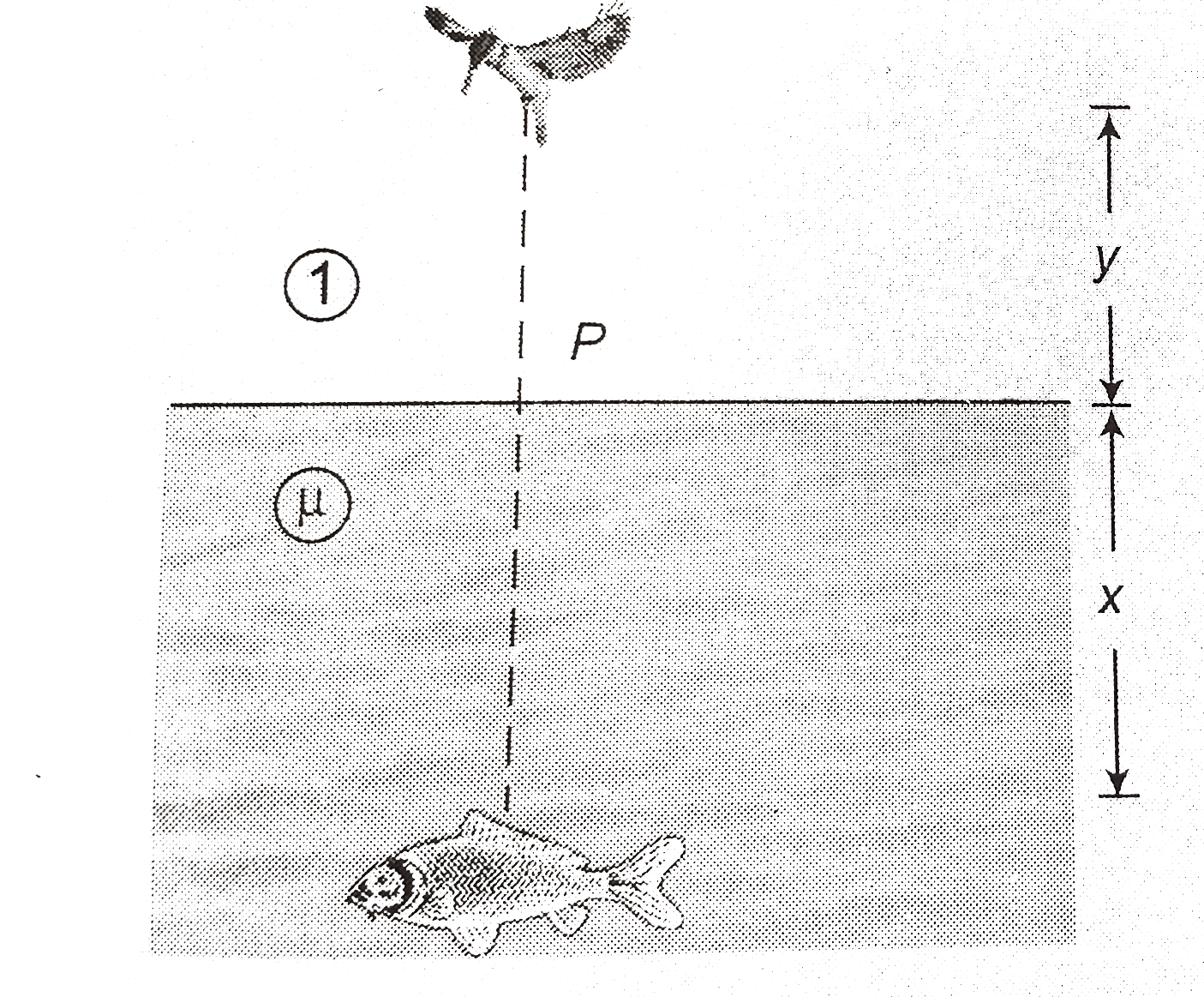
Find the distance between bird and fish as seen by (a) bird and (b) fish02:18View SolutionA fish rising up vertically toward the surface of water with speed `3ms^(-1)` observes a bird diving down vertically towards it with speed `9ms^(-1)` . The actual velocity of bird is
 02:28View Solution
02:28View SolutionConsider the situation shown in figure. A plane mirror is fixed at a height h above the bottom of a beaker containing water (refractive index `mu`) up of a bottom formed by the mirror.
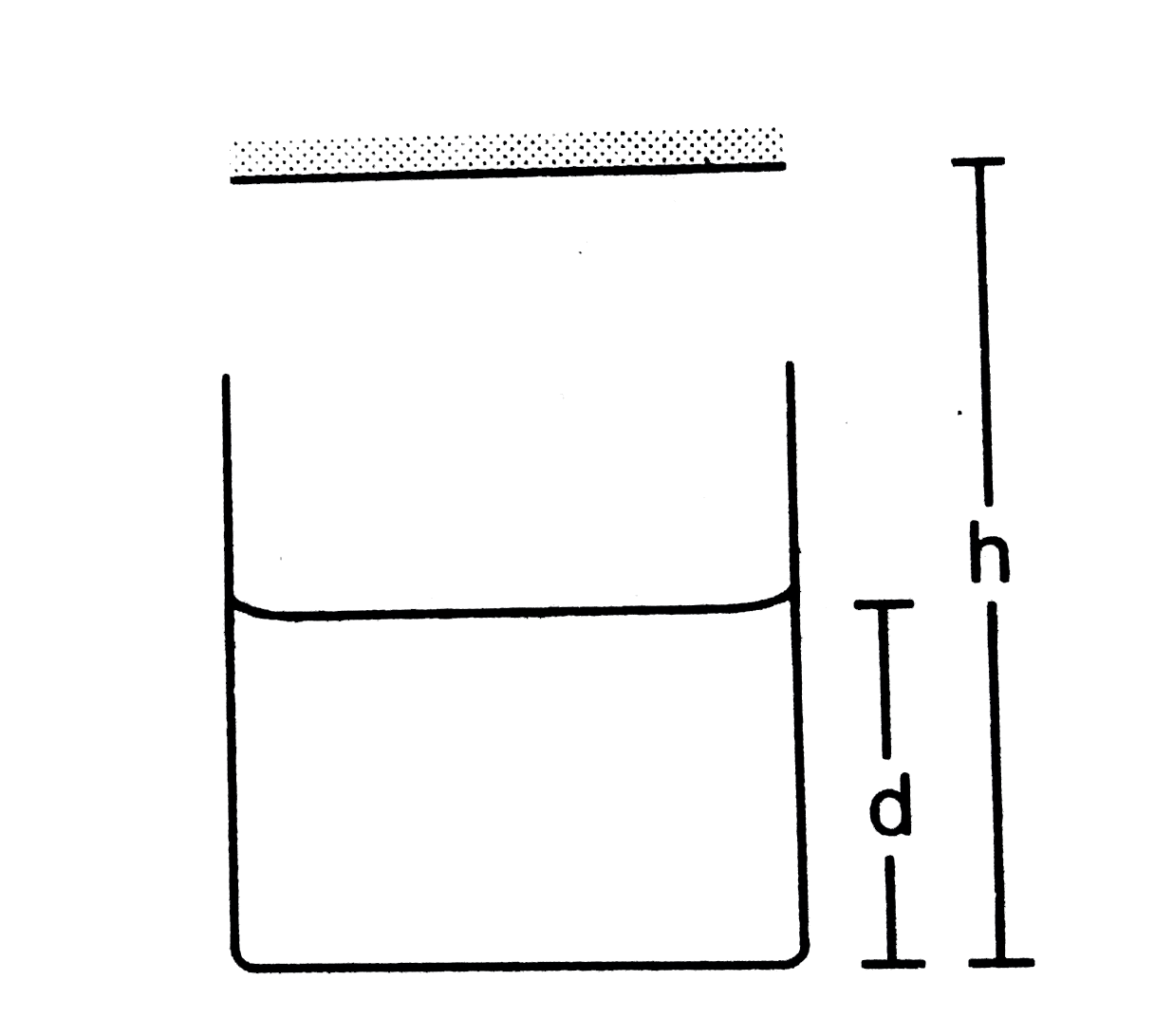 02:08View Solution
02:08View SolutionA concave mirror of radius of curvature one meter is placed at the bottom of a tank of water. The mirror forms an image of the sun when it is directly overhead. Calculate the distance of the images from the mirror for (a) `80cm` and (b) `40cm` of water in the tank ( `mu=4//3` for water)
08:47View SolutionConsider the situation in figure. The bottom of the pot is a reflecting plane mirror, S is a small fish and T is a human eye. Refractive index of water is mu. (a) At what distance(s) from itself will the fish see the image(s) of the eye ? (b) At what distance(s) from itself will the eye see the image(s) of the fish. (11-T
 07:48View Solution
07:48View Solution
Consider the situation shown in figure. Find distance of image of P from eye E.02:34View SolutionAn object is located at the bottom of a tank containing two immiscible liquids and is seen vertically from above. The lower and upper liquids are of depths `h_1` and `h_2` respectively and of refractive indices `mu_1` and `mu_2` respectively. Locate the position of the image of the object O from the surface.
03:19View SolutionFind the distance of final image from mirror.
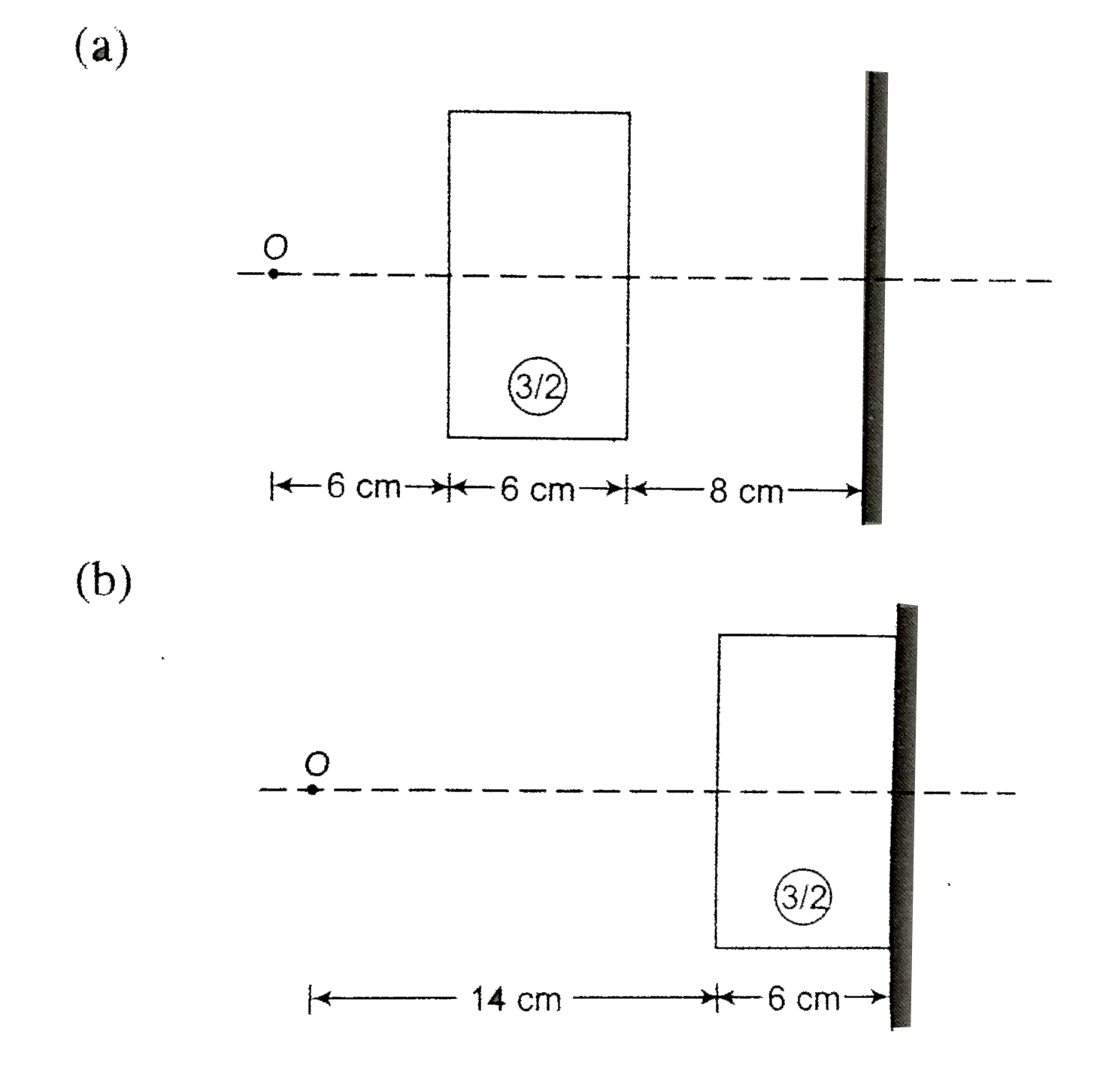 07:07View Solution
07:07View SolutionA vessel having perfectly reflecting plane botton is filled with water `(mu=4//3)` to depth d. A point source of light is placed at a height h above the surface of water. Find the distance of final image from water surface.
02:56View SolutionAn object is placed 21 cm in fron of a concave mirror of radis of curvature 20 cm.A glass slab of thicknes 3 cm and refractive index 1.5 is palced close to the mirror in the space between the object and the mirror. Find the position of the final image fromed. The distance of the nearer surface of the slab from the mirror is 10 cm.
03:26View SolutionAn object is placed 21 cm in front of a concave mirror of radius of curvature 10cm. A glass slabe of thickness 3cm and refractive index 1.5 is then placed close to the irror in the space between the object and the mirror. The distance of the near surface of the slabe from the mirror is 1cm. The final image from the mirror will be formed at
02:56View SolutionA light ray is incident at an angle of `45^@` with the normal to a `2cm` thick plate `(mu=2.0)`. Find the shift in the path of the light as it emerges out from the plate.
06:17View SolutionConsider a tin can of height h as shown in the figure. A coin lies on the botttom at the centre. From the position shown you can barely see the far side of the bottom of the can. When the can is slowly filled with water of refractive index `mu`, coin is just visible when the can is full. Show that the ratio of the height to radius is
`h/r=2sqrt((mu^2-1)/(4-mu^2))`
 05:56View Solution
05:56View SolutionLight from a denser medium 1 passes to a rarer medium 2. When the angle of incidence is `theta` the partially reflected and refracted rays are mutually perpendicular. The critical angle will be
 03:08View Solution
03:08View SolutionAB and CD are surfaces of two slabs as shown in figure. The medium between the slabs has refractive index 2, refractive index of slab above `AB` is `sqrt2` and below CD is `sqrt3`. Find the minimum angle of incidence, so that the ray is totally reflected by both the slabs.
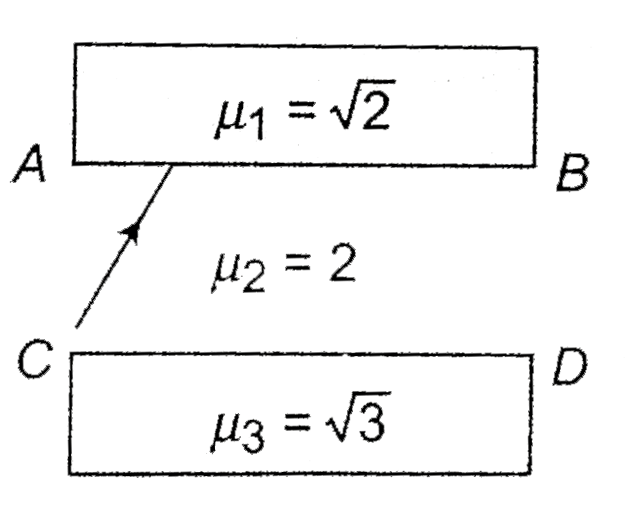 02:58View Solution
02:58View SolutionA rectangular glass block of thickness 10 cm and refractive index 1.5 placed over a small coin. A beaker is filled with water of refractive index `4//3` to a height of 10 cm and is placed over the glass block.
(a) Find the apparent position of the object when it is viewed at near normal incidence.
(b) if the eye is slowly moves away from the normal at a certain position, the object is found to disappear, due to total internal reflection. At what surface does this happen and why ?10:22View SolutionA ray of light traveling in glass `(mu=3//2)` is incident on a horizontal glass-air surface at the critical angle `theta_(C)`. If a thin layer of water `(mu=4//3)` is now poured on the glass-air surfac, the angle at which the ray emerges into air at the water-air surface is
01:44View SolutionA luminous object O is located at the bottom of a big pool of liquid of refractive index `mu` and depth h. The object O emits rays upwards in all directions, so that a circle of light is formed at the surface of the liquid by the rays which are refracted into the air. what happens to the rays beyond the circle ? Determine the radius and the area of the circle .
04:28View SolutionA bulb is placed at a depth of `2sqrt7cm` in water and a floating opaque disc is placed over the bulb so that the bulb is not visible from the surface. What is the minimum diameter of the disc?
05:22View SolutionA rectangulat block of refractive index `mu` is placed on a printed page lying on a horizontal surface as shown in Fig. , Find the minimum value of `mu` so that the letter L on the page is not visible from any of the vertical sides.
 01:03View Solution
01:03View SolutionConsider the situation shown in figure. Find the maximum angle theta for which the light suffers total internal reflection at the vertical surface.
03:14View SolutionA ray of light travels from a medium of refractive index `mu` to air. Its angle of incidence in the medium is `i` and its angle of deviation is `delta`. (a) What is the angle of deviation for `i lt C` and `i gt C`, where Ci s the critical angle. (b) Plot a curve between angle of deviation `delta` versus angle of incidence `i`.
08:44View SolutionA glass rod having square cross-section is bent into the shape as shown in the figure. The radius of the inner semi-circle is R and width of the rod is d. Find the minimum value of `d//R` so that the light that enters at A will emerge at B. Refractive index of glass is `mu=1.5`
 04:01View Solution
04:01View SolutionA point source of light is placed at a distance h below the surface of a large and deep lake. Show that the fraction f of light that escape directly from water surface is independent of h and is given by
`f=[[1-sqrt(1-1//mu^2)])/2`08:47View Solution(a) If the refracting angle of a prism is `60^@` and the minimum deviation is `30^@`, then find the angle of incidence.
(b) A ray of light passes through an equilateral prism such that the angle of emergence is equal to the angle of incidence and each is equal to `3//4^(th)` of the angle of prism. Find the angle of deviation.
(c) The refracting of a prism is A and the refractive index of the material of the prism is `cotA//2`. Find the angle of deviation.
(d) The angle of a prism is `60^@`. What is the angle of incidence for minimum deviation? The refractive index of the material of the prism is `sqrt2`.09:21View SolutionA ray of light passing through a prism having refractive index `sqrt2` suffers minimum deviation. It is found that the angle of incidence is double the angle of refraction within the prism. What is the angle of prism?
02:12View SolutionA prism ABC of angle `30^(@)` has its face AC silvered. A ray of light incident at an angle of `45^(@)` at the face AB retraces its path after refraction at face AB and reflection at face AC . The refractive index of the material of the prism is
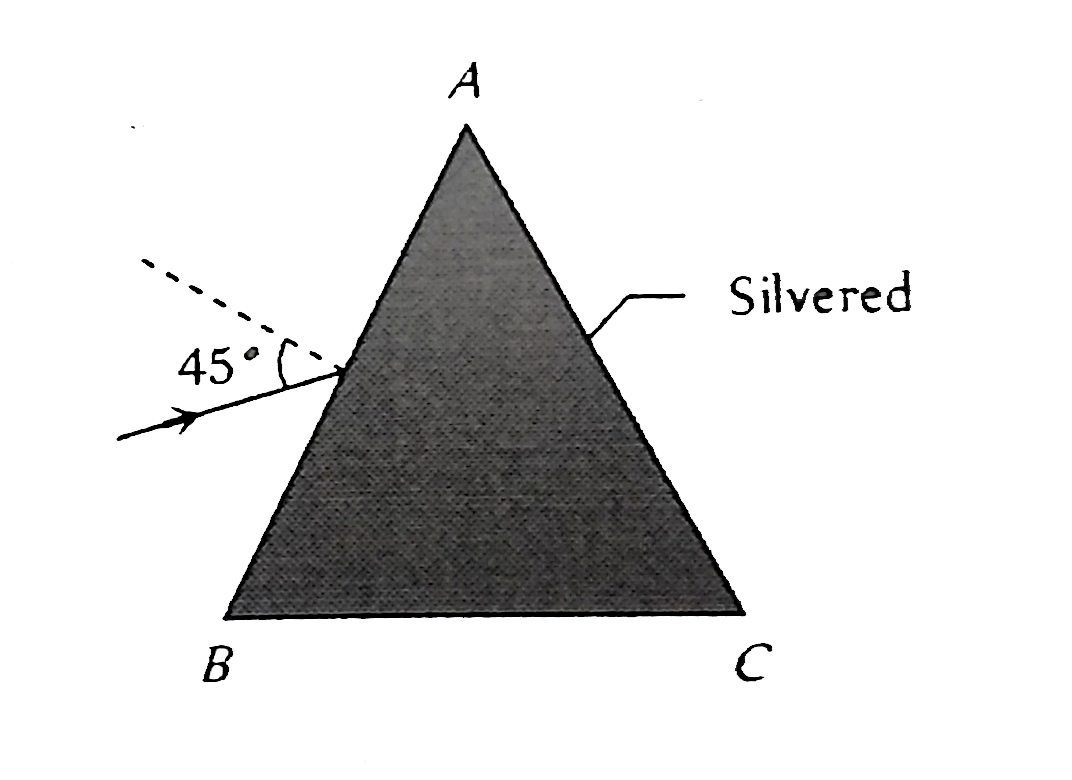 02:31View Solution
02:31View SolutionA ray of light undergoes deviation of `30^@` when incident on an equilateral prism of refractive index `sqrt2.` what is the angle subtended by the ray inside the prism with the base of the prism?
02:58View SolutionA ray of light is incident at an angle of `60^@` on the face of a prism having refracting angle `30^@.` The ray emerging out of the prism makes an angle `30^@` with the incident ray. Show that the emergent ray is perpendicular to the face through which it emerges and calculate the refractive index of the material of prism.
02:36View SolutionA `60^@` prism has a refractive index of `1.5`. Calculate (a) the angle of incidence for minimum deviation (b) angle of minimum deviation ( c) the angle of emergence of light at maximum deviation (d) angle of maximum deviation.
04:59View SolutionAn isosceles prism has one of the refracting surfaces silvered. A ray of light is incident normally on the refracting face AB. After two reflections, the ray emerges from the base of the prism perpendicular to it. Find the angle of the prism.
04:11View SolutionA ray of light incident normally on one of the faces of a right-angle isosceles prism is found to be totally reflected as shown in the figure. What is the minimum value of the refractive index of the material of the prism? When the prism is immersed in water, trace the path of the emergent ray for the same incident ray, indicating the values of all the angles `(mu_omega=4//3)`.
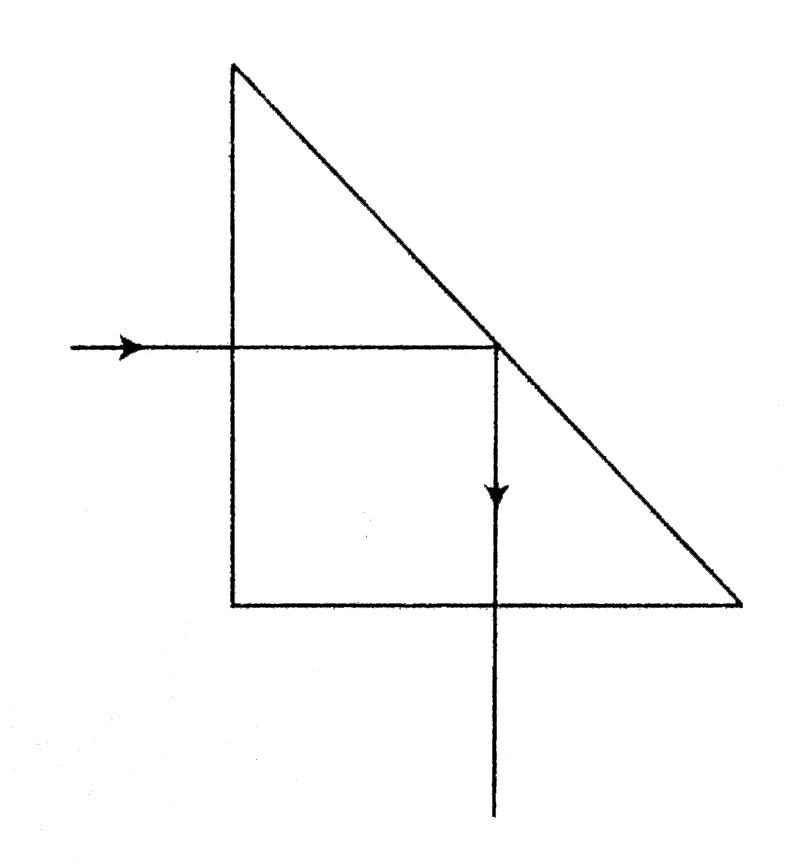 06:32View Solution
06:32View SolutionA light rays is incident on a prism of prism angle A and refractive index `mu`. Show that the smallest value of the angle of incidence for which the reflected ray does not suffer total internal reflection at the second face, i.e. just comes out of it, is given by
`i=sin^-1[(mu^2-1)^(1//2)sinA-cosA]`.06:58View SolutionA prism of refractive index `n_(1)` & another prism of reactive index `n_(2)` are stuck together without a gap as shown in the figure.The angle of the prisms are as shown. `n_(1)&n_(2)`depend on`lambda`,the wavelength of light according to `n_(1)=1.20+(10.8xx10^(4))/(lambda^(2)) & n_(2)=1.45+(1.80xx10^(4))/(lambda^(2))` where `lambda` is in nm.

(i)Calculate the wavelength `lambda_(0)`for which rays incident at any angle on the interface`BC`pass through without bending at that interface.
(ii) for light of wavelength `lambda_(0)`,find the angle of incidencei on face`AC`such that the deviation produced by the combination of prism is minimum.04:50View SolutionA right angles prism `(45^(@),90^(@), 45^(@))` of refractive index n has a plate of refractive index `(n_(1)ltn)` cemented to its diagonal face. The assembley is in air. A ray is incident on AB.
a. Calculate the angle of incidence at AB for which the ray strikes the diagonal face at the critical angle.
b. Assuming `n=1.351`, calculate the angle of incidence at AB for which the refracted rey passes through the diagonal face undeviated.
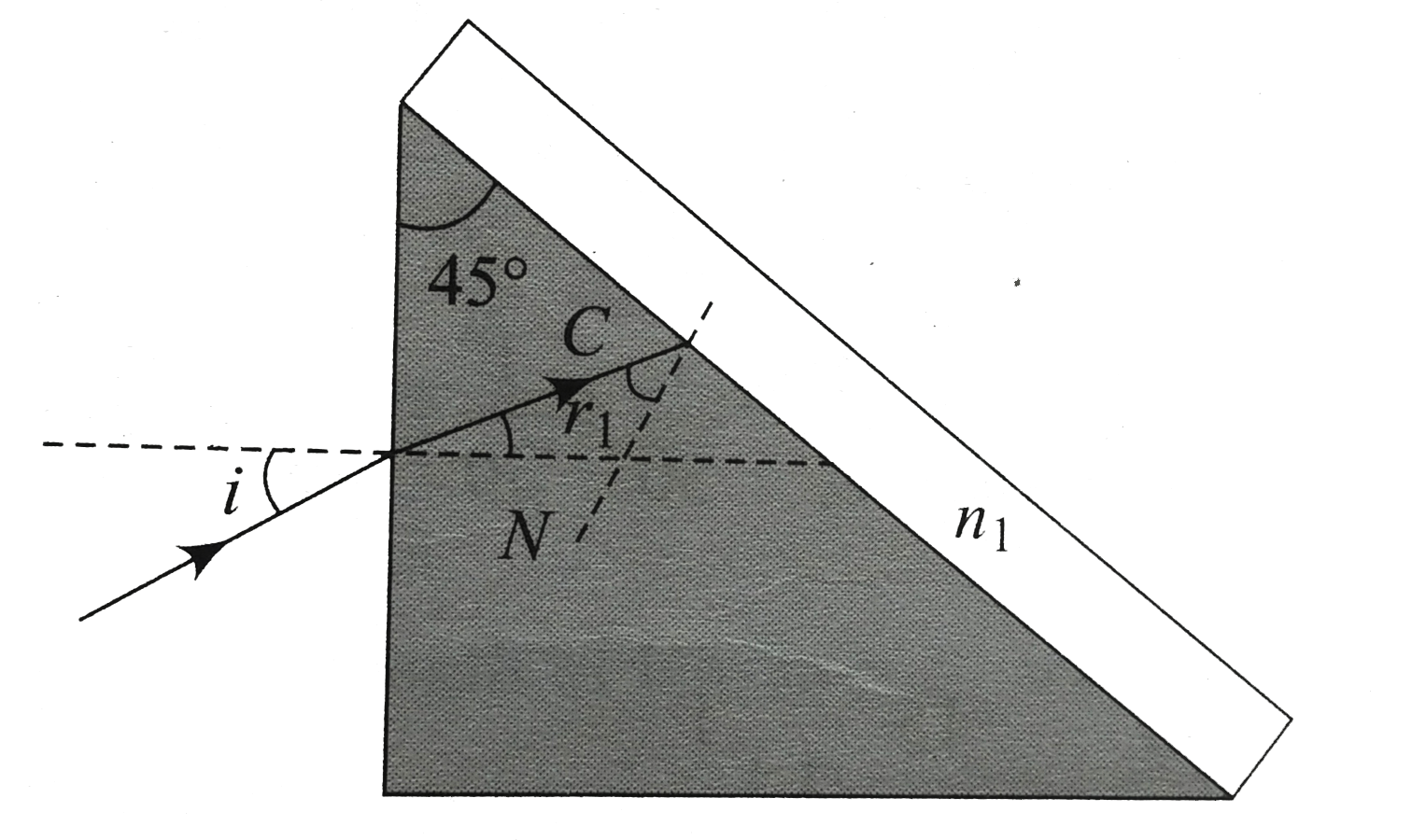 06:56View Solution
06:56View SolutionFind the dispersive power of flint glass. The refractive indices of flint glass for red, yellow and violet light are 1.613, 1.620 and 1.632 respectively.
01:54View SolutionThe refractive indices of flint glass for red and violet light are `1.613` and `1.632` respectively. Find the angular dispersion produced by the thin prism of flint glass having refracting angle `5^@`.
01:22View SolutionWhite light is passed through a prism of angle `5^@`. If the refractive indices for red and blue colours are `1.641` and `1.659` respectively, calculate the angle of deviation between them, also calculate the dispersive power.
03:05View SolutionA crown glass prism of angle of `5^@` is to be combined with a flint glass prism in such a way that the mean ray passes undeviated, find (a) the angle of the flint glass prism needed and (b) the angular dispersion produced by the combination when white light goes through it. Refractive indices for red, yellow and violet light are 1.514, 1.517 and 1.523 respectively for crown glass and 1.613, 1.620 and 1.632 for flint glass.
04:51View SolutionThe refractive indices of the crown glass for violet and red lights are`1.51`and `1.49`respectively and those of the flint glass are`1.77`and`1.73`respectively A prism of angle `6^(@)`is made of crown glass .A beam of white light is incident at a small angle on this prism.The other thin flint glass prism is combined white the crown glass prism such that te net mean deviation is`1.5^(@)`anticlockwise.
(i)Determine the angle of the flint glass prism.

(ii)A screen is placed normal to the emerging beam at a distance of`2m`from the prism combination.find the distance between red and violet spot on the screen Which is the topmost colour on screen.08:32View SolutionThe dispersive powers of crown and flint glasses are `0.03` and `0.05` respectively. The refractive indices for yellow light for these glasses are `1.517` and `1.621` respectively. It is desired to form an achromatic combination of prism of crown and flint glasses which can produce a deviation of `1^@` in the yellow ray. Find the refracting angles of the two prisms needed.
06:30View Solution
Examples questions and complete solutions for chapter REFRACTION OF LIGHT BY PLANE SURFACES of CP SINGH PHYSICS (HINGLISH) of Class 12
